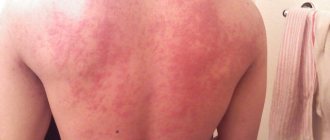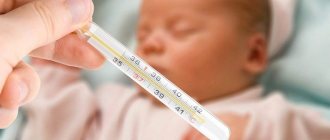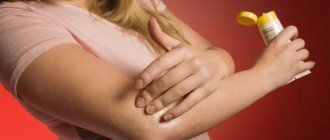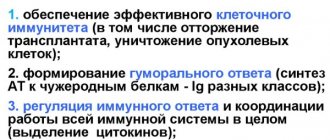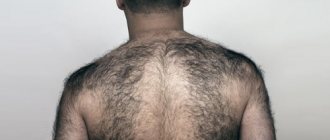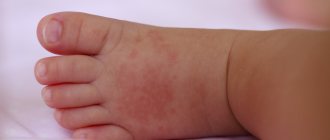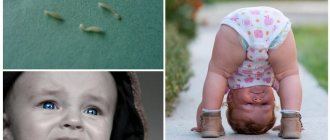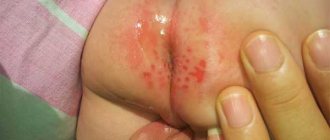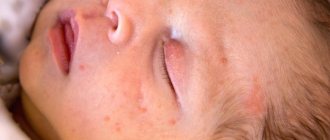Many young parents are often faced with various diseases of their young children. Allergies are common. The baby’s weak immunity does not yet know how to respond correctly to external and internal stimuli, which provokes the problem. Among the manifestations of allergies, it is worth noting rash, insomnia, digestive system disorders and others. Rashes and pimples appear on different parts of the body. But, most often, the places of localization are the butt and face. What is this allergy to a child’s bottom, and what are the causes of its occurrence?
The main causes of butt allergies in children
There can be many reasons for a child to develop allergies. First of all, it is heredity. If at least one of the blood relatives in the family suffered from allergies, the risk of the disease in the child increases significantly. Next, it is worth noting the baby’s weak immunity. The fact is that the human immune system is formed up to 3-5 years. Frequent illnesses of children from birth to 5-6 years are associated with this.
As for allergies in children, which manifest themselves on the butt, several factors need to be eliminated. The first of these is nutrition. If the regime and quality of the diet are violated, the child’s sensitive body reacts with a rash on the butt, cheeks, and back. Also, introducing complementary foods too early can contribute to this disease. Allergens can enter the baby's intestines through mother's milk. Therefore, as soon as a young mother discovers a rash on her baby’s bottom, it’s worth reviewing her own menu.
So, a woman’s nutrition should be exclusively dietary. You should not eat fatty, fried, sweet, smoked and salty foods. The following foods can cause allergies in a child:
- Cow's milk;
- Chocolate;
- Tomatoes;
- Strawberry;
- Citrus;
- Mushrooms;
- Nuts;
- Honey;
- Chicken eggs;
- Seafood;
- Soybeans, beans.
Many experts advise replacing cow's milk with goat's milk if you have allergies. Of course, it is better to prolong breastfeeding as much as possible. After all, it is through mother’s milk that the child’s body receives all the minerals, vitamins and microelements it needs. But, there are a number of reasons why breastfeeding is impossible. Also, today you can purchase various hypoallergenic dairy-free formulas for feeding babies.
The second common cause of butt allergies in babies is diapers. Very often, a baby’s skin exhibits allergic reactions to the components of such hygiene products. In such cases, experts advise parents to change the type and manufacturer of diapers to better ones. A rash on the butt can occur as a result of wearing a diaper for a long time. It is very important for parents to monitor the condition of the baby’s skin. Due to prolonged contact of urine and the child’s skin, an allergic reaction occurs.
Therefore, you need to change such hygiene products as often as possible. Wash your baby more often and use baby powder. After all, simple diaper rash on the butt very quickly develops into an allergic rash. As soon as a child begins to crawl and walk, any environmental objects can act as allergens. When a baby comes into contact with household chemicals, allergic reactions often occur. It is worth noting that this contact may not be direct. It is enough just to rinse your child’s washed clothes poorly for an allergy to appear. In such cases, it is better to change the powder and iron the baby’s clothes.
Among other causes of allergic rashes on a child’s bottom, it is worth noting the following:
- Dust;
- Plant pollen;
- Animal wool;
- Medications;
- Hygiene products.
Rash on buttocks in babies
A rash on a child's bottom can appear for many reasons. A child’s body reacts much more sharply to various negative factors than an adult’s body.
A common reaction in infants (and older children) to unfavorable factors is allergic manifestations on the bottom in the form of a rash.
Rashes can be of different nature, not only allergic. Doctors strongly recommend that if any rash appears, you should immediately consult a doctor to prevent possible serious complications.
What can cause a rash on a baby's bottom?
There are a number of reasons why rashes of various types appear on a child’s bottom.
- Exudative diathesis, in which, against the background of diaper rash, first nodules appear on the butt (they are very itchy), then blisters, then erosion. The disease is fraught with transition to wet eczema. Such rashes are treated with diet, antihistamines and local remedies.
- Miliaria, which appears from overheating, is quite typical for infants. These are small dots
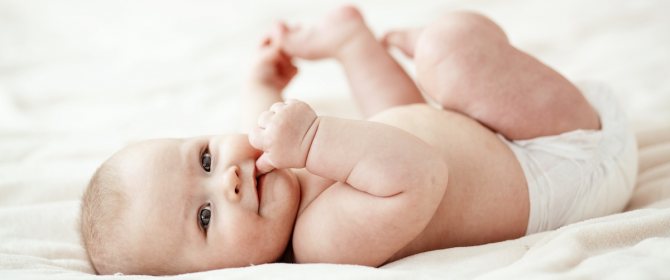
which will go away if you stop overheating the child and bathe him in baths with the addition of potassium permanganate. - Contact dermatitis, which causes a thick rash on the baby’s bottom, can be caused by certain brands of diapers, creams, and washing powders. Rashes are treated with decoctions and infusions of calendula, string, chamomile (added to the water in which the child is bathed).
- Toxic erythema looks like spots and blisters that tend to merge. Regular green paint can help here.
- Pustular diseases in the form of spots appear due to the penetration of streptococci or staphylococci. The doctor will determine whether local remedies are sufficient or whether antibiotic therapy is also needed.
- Fungal diseases usually appear as red spots with blisters and crusts. The doctor will prescribe antifungal medications.
- Rash caused by allergies. If a mother nursing a baby does not follow a hypoallergenic diet, rashes of allergic origin may occur on the baby's bottom. This rash also occurs in older children as a reaction to various irritants. A specialist will help by identifying the allergen and prescribing the correct therapy.
In addition, the cause of rashes can be mosquito bites, scabies mites, as well as a variety of infectious diseases.
The main thing that parents should remember: if a nodular rash appears, either in the form of spots or pustules, or a white or red rash on the child’s bottom, a visit to the doctor cannot be postponed.
Allergy or other rash?
An allergic rash in a child and many types of other rashes are often similar.
However, an allergic reaction in the form of a rash does not only occur in one place (for example, on the butt), it also occurs in other parts of the body.
According to doctors, rashes of an allergic nature on the butt are typical for children with reduced immunity.
- Some foods are allergens (for example, in the case of infants, a rash may appear when introducing a new diet, during artificial feeding, and also if the mother is breastfeeding but does not follow an anti-allergenic diet). Doctors include red vegetables and fruits, citrus fruits, cocoa-containing products, nuts, and seafood as the most powerful allergens.
- An allergic reaction can occur to certain brands of diapers, washing powders used to wash children's clothes, children's cosmetics, and household chemicals.
- The child may react to plant pollen.
- Allergic rashes can be caused by household dust, which contains many mites. There are especially many of them in pillows, bedding, and carpets.
- The cause of an allergy in the form of a rash on the butt and in other places can be a cat (its saliva and urine contain protein, which is an allergen).
An allergic rash on a child's bottom (photos of such red rashes can be easily found on the Internet) and diaper rash, prickly heat - these are very different things.
The allergy will go away only after you stop contacting the allergen. Also, with allergic reactions in the form of rashes, there is no bacterial inflammation.
Self-medication for any type of rash on a child’s bottom is prohibited. Only a doctor can diagnose the type of rash and prescribe adequate individual therapy.
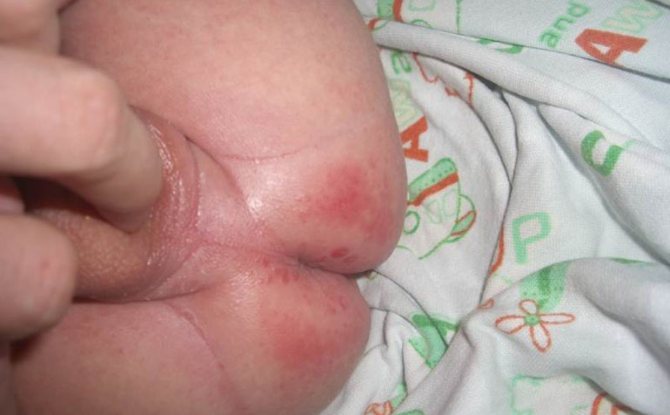
How to treat a rash due to allergies in a child
If the rash is caused by an allergy, treatment includes:
- Antihistamines: These block histamine, which is produced in excess in the body during allergies. The doctor will select the necessary new generation medications. For the youngest children, they produce not tablets, but syrups and sweetened drops.
- Local remedies, including infusions and decoctions of herbs (the doctor will also recommend herbs).
- Sometimes medications may be prescribed to help the immune defense.
Preventative measures against allergic rashes
- If this is an infant, the rash can be prevented by avoiding overheating and sweating. It is also necessary to use only those diapers that do not cause irritation. A hypoallergenic diet for a breastfeeding mother and monitoring the baby when introducing new complementary foods is very important.
- For both infants and older children, prevention will include minimizing skin contact with a potential allergen.
- Contact with possible allergens that may enter the child’s body should be excluded.
- Regular wet cleaning and ventilation of the room are recommended.
- When washing children's clothes, you need to use hypoallergenic washing powders.
- It is necessary to avoid flowering plants in the child's room.
When the first allergic symptoms appear, you need to show the child to a specialist.
Signs of an allergy to a child's bottom
The signs of allergies and mechanical irritation of the skin on the butt are almost identical. Therefore, recognizing an allergic reaction is quite difficult. Only a qualified specialist will come to help. Very often, mothers confuse allergies with simple diaper rash. Redness on the butt from diaper rash occurs only when different parts of the body remain in a humid environment for a long time. It is moisture that causes irritation. As soon as this factor is eliminated and the child is bathed, these signs will immediately disappear.
In the case of an allergy to the butt, the rash disappears a few days after stopping contact with the allergen. The following symptoms are characteristic of an allergic manifestation:
- Pappulae;
- Vesicles;
- Erythema;
- Atopic dermatitis;
- Hives.
The most common types of allergic rashes on a child’s bottom are urticaria and atopic dermatitis. Hives manifest themselves in the form of small pink spots and pimples. They often cause severe discomfort in the form of itching, burning, and peeling. Because of this, children become irritable, often cry, and suffer from insomnia. It is worth noting that allergic urticaria spreads over time throughout the body, and not just on the butt.
Atopic dermatitis looks like pimples, blisters, and red spots. If left untreated, pimples on the butt merge into weeping blisters. In some cases, an allergy to the butt becomes a symptom of an autoimmune disease of the child’s skin. Such inflammation of the skin in the early stages does not pose a great danger. But, over time, bacteria penetrate into damaged areas of the skin, which provoke pyoderma - bacterial inflammation. Therefore, butt allergies should be treated immediately.
Other types of rashes in newborns
It is imperative to take into account that a rash on the butt can be a harbinger of inflammation in other areas of the skin. The entire surface area of a child may be responsible for the same pathologies. It's just that sometimes pimples appear earlier in certain areas. You need to understand all types of diseases that can cause bum pimples so that you can prepare for any situation.
Experts often discuss this topical topic to a wide audience. Be sure to watch the video below, in which an experienced pediatrician shares recommendations for independently determining the type of rash and infant:
An equally pressing question is how to treat irritation on a child’s bottom. As mentioned, the main source of rash in the summer can be the diaper. The recommendations listed in the video below will help you quickly get rid of irritation and put your baby in order. They can be combined or used separately:
A rash on the butt in newborns is a fairly common phenomenon, which, however, requires special attention from parents. Possible types will help you quickly identify the disease. In addition, we recommend that you read the article about rashes on the face of a newborn.
Pimples on a child's bottom not only cause him discomfort, but also become a cause for concern for parents.
And the younger the child, the greater their anxiety about such a symptom.
Sometimes this concern is completely justified, because pimples on the buttocks are not always safe.
- All information on the site is for informational purposes only and is NOT a guide to action!
- can give you an ACCURATE DIAGNOSIS !
- We kindly ask you NOT to self-medicate, but to make an appointment with a specialist !
- Health to you and your loved ones!
How to treat butt allergies in a child?
During treatment, first of all, it is necessary to eliminate the main allergen (food, animal, dust, pollen, household chemicals). Only after this can drug therapy begin. Having identified the main cause of the rash on the butt, specialists prescribe certain medications, most often antihistamines. It is important to remove the allergen from the baby’s body in a short time. To do this, you can give your baby an enterosorbent by dissolving it in water.
As for antihistamines against allergies, not every drug is approved for children. It is very important to choose tablets with a mild effect so as not to cause serious adverse reactions. There are three generations of such funds. For children, doctors most often prescribe first-generation antihistamines:
- Suprastin;
- Tavegil;
- Diphenhydramine;
- Claritin.
If the baby does not accept the tablets, even crushed ones, there are a variety of antihistamine drops. They will help relieve the child of allergies on the bottom, remove the allergen from the body, and strengthen the immune system. Zyrtec allergy drops are very popular. If a bacterial infection is associated with the rash on the butt, treatment with antibiotics is necessary. Antibiotics, both tablets and ointments, are prescribed exclusively by a doctor. Only a qualified specialist will be able to select a drug with minimal damage to the overall health of the baby.
An allergy to a child's bottom requires local therapy. Creams and ointments for children can be hormonal and non-hormonal. Hormonal remedies for butt allergies are used extremely rarely. Such drugs contain a small amount of corticosteroids that penetrate through the skin into the blood. This can provoke a change in natural hormonal levels. In addition, children under 3-5 years of age are often a contraindication to their use.
Non-hormonal ointments have virtually no side effects or contraindications. Such products have a cooling, anti-inflammatory, and antibacterial effect. Due to the rapid cooling of the skin, the child gets rid of itching and burning. In a fairly short period of time, both redness and rash on the butt are eliminated. The following products are allowed for children of any age:
- Fenistil gel;
- Skin Cap;
- Elidel;
- Gistan;
- Desitin;
- Protopic;
- Wundehil.
Video: “Rash in children - Doctor Komarovsky”
Most parents face the problem of acne on their child's bottom. These pimples usually appear in groups at once, and the rash can appear suddenly and quickly disappear without any treatment. When acne forms on a child’s bottom, either isolated or massive, it is necessary, firstly, to establish the cause of this phenomenon, and for this you may need to consult a doctor. After it is determined why acne appears on the child’s bottom, the specialist prescribes treatment and gives advice on caring for the baby.
